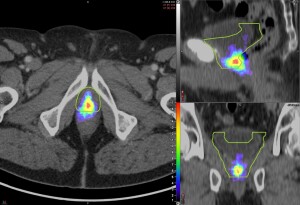by
John R. Fischer, Senior Reporter | April 04, 2023

A new study says that PSMA PET scans should be used to collect insights for radiotherapy contouring guidelines in prostate cancer care.
Nuclear medicine physicians are calling for radiotherapy contouring guidelines to be refined with insights from PSMA PET imaging to more accurately target and eliminate lesions without irradiating healthy tissues.
Approved by the FDA in December 2020, PSMA (Prostate-specific membrane antigen) PET scans have been increasingly used to map out tumor recurrence following prostatectomies. The intravenous injection binds to the PSMA, of which prostate cancer cells show high levels, emitting positrons that the PET scan picks up, identifying the cancerous lesions.
Approximately one-third of patients who undergo prostatectomies see their disease worsen within 10 years but can be treated potentially with salvage radiation therapy, which is delivered in accordance with contouring guidelines.



Ad Statistics
Times Displayed: 365886
Times Visited: 7102 Quality remanufactured Certified Centrifuges at Great prices! Fully warranted and backed by a company you can trust! Call or click for a free quote today! www.Centrifugestore.com 800-457-7576
But in a new study,
PSMA PET/CT–based Atlas for Prostatic Bed Recurrence after Radical Prostatectomy: Clinical Implications for Salvage Radiation Therapy Contouring Guidelines, University of California, Los Angeles researchers say that contouring guidelines for identifying areas to apply treatment miss a significant number of tumors and unnecessarily damage healthy tissue.
They say the problem is that recommendations are based on expert consensus, rather than information supplied by PSMA PET imaging.
“Our work confirms the crucial and growing role that nuclear medicine and molecular imaging have in guiding decision-making for cancer treatment,” said Dr. Ida Sonni, a nuclear medicine physician and academic researcher in the radiological sciences department at UCLA, in a statement.
Researchers performed PSMA PET scanning on 127 patients with PSA persistence or biochemical recurrence following their prostate cancer surgery. Assessing the location of recurrent lesions, they used Radiation Therapy Oncology Group (RTOG) contouring guidelines to determine the clinical target volume (CTV), and classified each lesion as completely covered, partially covered or not covered by the contouring guidelines.
Among 53% of patients, recurrent lesions were covered. In 34%, they were partially covered, and not at all in 13%. Some areas in the CTV had no lesions at all.
Another recent study, presented at the European Association of Urology 2023 Annual Meeting, also found that PSMA-PET/CT imaging, when added to multiparametric MR, led to changes in intramodal treatment plans that allowed clinicians to detect more clinically significant prostate tumors,
according to Medscape.
Additionally, a study published in
The Journal of Nuclear Medicine found that PSMA PET/MR
can determine if cancer is likely to return within two years of a prostatectomy, allowing physicians to provide additional treatment and surveillance to these patients early on.
The findings in the UCLA study were also published in
The Journal of Nuclear Medicine.

